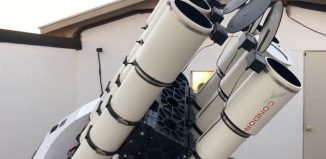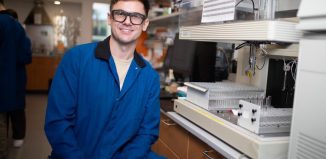CSHL’s Kepecs tracks neurons and confidence
What humans, or any other animals, think about the world can be seen in pathways that flash around in the brain, forming connections that inform a view of anything from the smell of steaming hot pizza to directions to a rink for a roller-skating party.
Combining behavioral electrophysiology with quantitative psychophysics and optogenetics, Adam Kepecs, an associate professor at Cold Spring Harbor Laboratory, is specifically looking at how rats report confidence in their decisions.
Looking at the frontal cortex in the brain, Kepecs studies the kinds of neurons that fire as the rat is weighing its options in the face of uncertainty. He likens the process to receiving directions to a restaurant and then following a route until there is no sign of the dining establishment.
“At some point, you will wonder, ‘Is the restaurant coming up or should I turn around?’” he said. “Presumably, the more confident you are, the longer you will keep driving. That’s exactly what we can do with rats. We can repeat [this experiment] hundreds of times a day by manipulating the instructions.”
To further the restaurant search analogy, that would be the equivalent of receiving instructions that were slightly garbled through a cell phone or where foliage obscured a sign a driver was expecting to see.
The directions the rat receives, Kepecs said, come from olfactory or auditory cues rather than visual ones. “We’re testing how you could turn this initial confidence into a choice,” he said. “We want to see how long do [they] wait.”
The analysis of the data he and his team of eight people collect comes from comparing a statistical evaluation of neurons that are within tens of microns of each other and the decisions that come from a rat that is faced with a choice about staying the course.
“This is a great statistical evaluation of how likely a decision was correct,” Kepecs said. Kepecs said these kinds of experiments enable him to study basic behaviors that get to the heart of how the rats process information and weigh that against what’s happening around them. “We’re trying to ask a big psychological question and we need to reduce it to an elemental behavior and turn it into something we can study as neuroscientists,” he said.
While Kepecs isn’t yet ready to extend his research to humans, he said the implications and applications of this research could include helping people who struggle with problems such as obsessive compulsive disorder. “If you lose confidence about your actions, you might repeat them,” he said. “This is the kind of thing [his research] is moving towards.”
Kepecs’ colleagues appreciate his approach to his research. “He is an outstanding scientist,” said Anthony Zador, the program chair of neuroscience at CSHL. He has a “well-earned reputation for being creative and innovative.”
In a separate line of experiments, Kepecs is also working with a region deep within the brain, called the nucleus basalis. Degeneration in this area has been linked to Alzheimer’s disease, Parkinson’s dementia and age-related cognitive declines.
Indeed, Kepecs recently received the 2014 Memory and Cognitive Disorders Award from the McKnight Endowment Fund for Neuroscience, which provides $100,000 a year for three years. The award supports research designed to solve problems of neurological and psychiatric diseases, with an emphasis on those that affect cognition and memory.
“This area has been a puzzle,” said Kepecs. “It’s made up of many cell types. Until now, there was no way of recording identified cells. What we’re trying to do is record from identified cholinergic neurons, to figure out what they’re telling the rest of the brain.”
Kepecs studied computer science in his native Budapest, Hungary. He was fascinated with the way the mind works. “I have a deep interest in the mind and computer science was my route,” he explained. A resident of Huntington, Kepecs is married with two children.
Kepecs said he is excited to take the next steps in linking activity in neural circuits to confidence. “How can you study anything that’s internal to your brain?” he asked. That is what his experiments on neurons and behavior are designed to examine.






